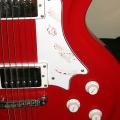The following is a guest post by Danny Dyson. If you are interested in guest posting, please contact me!
First of all, there is no absolute for great tone. What is there to factually and tangibly reference a ‘good’ tone? Obviously, there is no such thing as a tone meter.
While some guitarists are chasing a specific tone that they’re hearing in their head, there is a general ‘tone’ that you can aim for as a guitarist.
A good tone will (usually) not be too shrilly on the top end, and no too loose and saggy on the low end, with a good amount of midrange coming through. The goal is to get a focused sound that is pleasing to the ear, and extends off the stage into the audience naturally.
The best part is that killer guitar tone is very attainable with the right knowledge. I see far too many guitarists getting caught in the trap of the latest pedal, processor, amp, etc. The list goes on and on.
While your fingers can influence the tone you achieve with you guitar, there are some practical things that will help you on your journey toward good tone.
Changing Guitar Picks
One of the cheapest and easiest ways to tinker with your guitar sound is to experiment with different sizes and gauges of picks. A thicker pick tends to produce a darker sound, while thinner picks are more likely to produce a brighter sound. Although, super thick picks often produce a tone with less depth.
U2’s ‘The Edge’ has been known to use picks with some sort of grip on them such as the Dunlop Nylons or the harder to find Herdim picks. Supposedly he holds the pick backwards so that the grip part of the pick strikes the strings, which creates a bright ‘chime’ tone.

Changing String Gauges
Another easy way to alter your sound is via experimenting with different string gauges. A guitar strung with extra light gauge strings will sound completely different than the same guitar strung with medium or heavy gauge strings. It should be noted that changing string gauges on a guitar generally requires an intonation adjustment. Also, don’t forget to change your strings regularly. Old ‘dead’ sounding strings can make a $3000 guitar sound like a $300 guitar.
Experiment With Different Pickup Heights
Good quality pickups will produce a more complex and interesting sound. If you guitar sound is boring and lifeless, try getting some new pickups installed. Learn how to tweak you pickup height to optimize your guitar’s response. This makes a lot more of a difference than you might think, and in some unexpected ways!
Use Less Overdrive / Distortion
Use less than you think you need. I’m not sure of the physics behind why this is, but whenever I hear myself back on tape or hear someone else playing through my rig, I’m always struck by how much more distortion there is than I thought when I was playing. Also most amps do sound better cleaner.
Pedals: Less Is More
“True Bypass” is the big buzzword in the effects world these days, but it might not be the best option in every scenario. Learn where this format can maximize your tone, and where another approach might be a better way to go. In general, the more pedals you have, the more tone you stand to loose.

Tubes Are Better
Clued-in guitarists know that those glowing glass bottles are still the way to go for juicy rich tone. Tube amps not only saturate in a more manageable way producing a more pleasing distortion character, they also last longer. And don’t fool yourself: your amp is much more important than your guitar in creating a good tone. A cheapie Mexican strat can sound good through a high-quality rig, but nothing sounds good through a cheap trashy solid-state amp. Having said all that, there are great sounding solid-state amps out there, but they are the exception.
Find a Good Rhythm Tone
Most guitarists spend about 90% of their time practicing lead, but only 10% of their on-stage time actually playing lead. In between, you need to be able to make whoever is singing or playing sound good. When on stage, listen, REALLY LISTEN, to how your sound contributes to the overall sound of the band.
Leave The Bass To The Bassist
Rarely should you actively try to have more bass on your guitar. If you’re using a graphic EQ pedal to ‘fix’ your rig by adding more bass, something is wrong.
Your Say
How do you normally pull a good tone live? Have you discovered any tips that would help the rest of us?
About The Author
 Hi, I’m Danny Dyson and I’m the writer and creator behind http://www.RockYourGuitar.com. I have been playing guitar for over 20 years now and love it more every day.
Hi, I’m Danny Dyson and I’m the writer and creator behind http://www.RockYourGuitar.com. I have been playing guitar for over 20 years now and love it more every day.
I hope through my blog I can inspire and be inspired by other musicians. Music is a journey, and this is my way of sharing that.
You can check out my blog here: http://www.rockyourguitar.com




